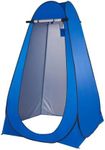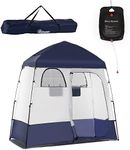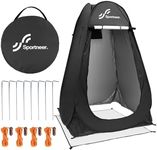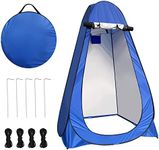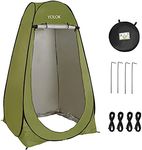Buying Guide for the Best Shower Tents
Choosing the right shower tent can make your outdoor adventures much more comfortable and private, whether you're camping, at the beach, or need a portable changing room. The best approach is to think about where and how you'll use the tent most often, how many people will use it, and what features will make your experience easier and more enjoyable. By understanding the key specifications, you can find a shower tent that fits your needs and makes your outdoor hygiene routine hassle-free.Size and DimensionsSize and dimensions refer to the overall footprint and height of the shower tent. This is important because it determines how much space you have inside to move around and whether you can stand up comfortably. Shower tents come in compact, single-person sizes, as well as larger, multi-person or double-room options. If you only need a tent for quick showers or changing, a smaller size may be enough. If you want more comfort, space for hanging clothes, or room for a portable toilet, a larger tent is better. Consider your height and how much gear you want to bring inside when choosing the right size.
Material and DurabilityThe material and durability of a shower tent affect how well it stands up to weather, wear, and repeated use. Most shower tents are made from polyester or nylon with a waterproof coating, and the frame is usually steel or fiberglass. Thicker materials and reinforced seams offer better protection from rain and wind, while lighter materials are easier to carry. If you plan to use the tent in rough weather or for long trips, look for sturdy materials and strong frames. For occasional use in mild conditions, lighter materials may be sufficient.
VentilationVentilation refers to how well air flows through the tent, which is important for comfort and reducing moisture buildup. Good ventilation comes from mesh windows, roof vents, or zippered openings. Some tents have multiple vents to allow steam to escape and keep the inside fresh. If you plan to use hot water or shower in warm weather, prioritize tents with more ventilation. For cooler climates or quick changes, less ventilation may be acceptable.
Privacy FeaturesPrivacy features include the thickness and opacity of the tent fabric, as well as design elements like zippered doors and covered windows. These features are important to ensure you feel comfortable and secure while showering or changing. Some tents have double-layered walls or blackout panels for extra privacy. If you’ll be using the tent in busy campgrounds or public areas, look for models with enhanced privacy. For remote locations, basic privacy may be enough.
Ease of SetupEase of setup describes how quickly and simply you can assemble and take down the tent. Some shower tents use pop-up designs that spring into shape, while others require poles and more assembly. If you want a tent you can set up alone or in a hurry, look for pop-up or instant models. If you don’t mind spending a few extra minutes for a sturdier structure, traditional pole tents may be suitable. Think about how often you’ll move the tent and whether you’ll have help when setting it up.
Floor DesignThe floor design refers to whether the tent has a built-in, removable, or no floor at all. A built-in floor keeps your feet clean and prevents water from escaping, but can make drainage tricky. Removable or mesh floors allow water to drain easily but may let in dirt. If you want a clean, dry space, choose a tent with a built-in or removable floor. For beach use or quick rinses, a floorless design may be more convenient.
Additional FeaturesAdditional features can include hooks for hanging a shower bag, pockets for toiletries, towel racks, or even separate compartments for changing and showering. These extras can make your experience more comfortable and organized. If you value convenience and like to keep things tidy, look for tents with more built-in features. If you prefer simplicity, a basic tent may be all you need.



